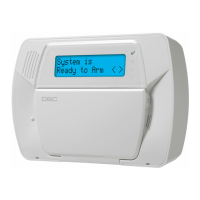5
your code within ___ seconds to avoid an alarm condition. Check with your installer to program this
time.
Disarming Error
If your code is invalid, the system will not disarm and a 2-second error tone will sound. If this hap-
pens, press [#] and try again.
4.8 Remote Arming and Disarming (Setting/Unsetting)
The system can be armed/set and disarmed/unset, using a remote control device (wireless key), if
programmed by the installer. When arming/setting the system using the Arm button on a wireless
key, the system will acknowledge the command by sounding a single bell/siren squawk, if pro-
grammed to do so by the installer. When disarming/unsetting using the Disarm button on a wireless
key, the system will acknowledge the command by sounding two bell/siren squawks. Three
squawks, when disarming/unsetting with the Disarm button, indicates that an alarm occurred while
the system was armed/set. If you are unsure of the cause of the alarm, proceed with caution (see
Two-Way Wireless Key (WT4989, WT8989).
5. Setting and Unsetting the Alarm System for Police Connected
Alarms (UK Installations only)
5.1 Alarm System Setting Methods
The SCW9055/SCW9057 is capable of completing the full alarm system setting procedure using
one of the following methods:
• push button switch mounted outside the supervised premises; or
• protective switch (i.e., door contact) fitted to the final exit door of the alarmed premises or area.
The setting procedure is a two-stage process that consists of initiating the alarm setting procedure
within the supervised premises (e.g., using a prox tag (PT4) or user code) followed by completion
of setting by one of the two methods mentioned above. Please check with the installer which method
has been enabled for your system.
5.2 Alarm System Unsetting Methods
The SCW9055/SCW9057 is capable of supporting the following alarm system unsetting methods in
accordance with BS8243-2010:
• Prevention of entry to the supervised premises before the SCW9055/SCW9057 is unset.
• Unsetting using the WT4989 wireless key before entering the supervised premises causes or per-
mits the initial entry door to be unlocked (section 6.4.2).
6. Emergency Keys
Press BOTH (Fire), (Auxiliary), or (Panic) buttons for 2 seconds to
generate a Fire, Auxiliary, or Panic alarm. The keypad buzzer will beep indicating that the alarm
input has been accepted and transmission to the central station is underway. The Fire buttons may or
may not sound the siren depending on installer setup.
NOTE: The Fire buttons can be disabled by the installer.
NOTE: The Auxiliary Alarm buttons are not intended to be used for medical signals.
7. When Alarm Sounds
The system can generate 3 different alarm sounds:
• Continuous Siren = Intrusion/Burglary Alarm
NOTE: The WT4911 siren will sound a dual frequency sweeping tone for burglary alarms.
• Temporal / Pulsed Siren = Fire Alarm
• 4 beeps, 5-second pause, 4 beeps = Carbon Monoxide alarm
NOTE: The priority of signals is fire alarm, carbon monoxide alarm then burglary alarm.

